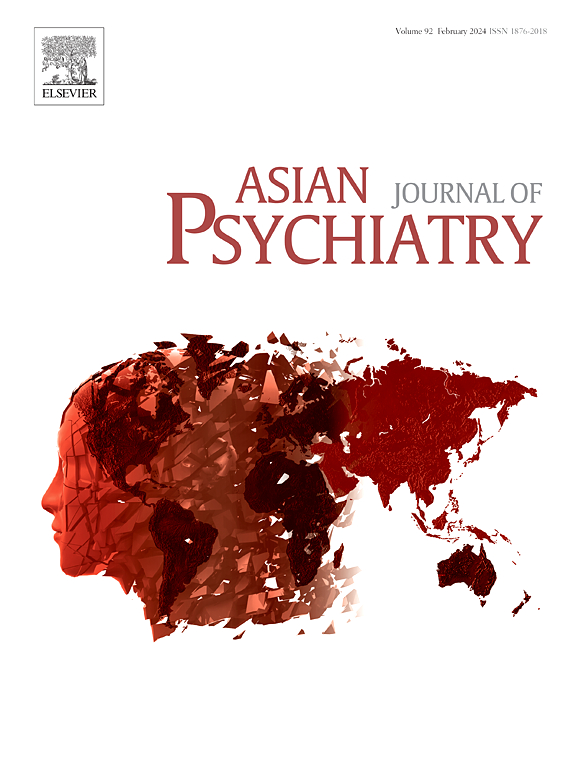年轻男子静脉注射非医用苯丙胺使用:印度三级成瘾治疗机构的连续病例系列
IF 4.5
4区 医学
Q1 PSYCHIATRY
引用次数: 0
摘要
甲非特明,一种取代的安非他明,作为一种拟交感神经剂,具有轻微的中枢神经系统兴奋特性。虽然被批准用于治疗低血压状态,但由于其提高成绩的潜力,它被世界反兴奋剂机构(WADA)禁止使用。非医疗用途的报告虽然很少,但主要出现在东南亚和美国。方法:本病例系列描述了2023年9月至11月期间在三级护理成瘾治疗机构中连续出现的12名非医疗使用甲基苯丙胺的参与者。通过结构化访谈、临床评估和尿液毒理学确认收集数据。结果新登记病例中,有0.71% %的病例存在非医疗用药,其中一半符合ICD-11的依赖标准。所有参与者均为受过教育的男性(平均年龄:25.6岁,SD = 5.1);58.3% %的人失业,50% %的人已婚。大多数人在运动、健身或职业环境中静脉注射甲芬特明以提高表现。中位日剂量为300 mg (IQR: 183.8-412.5),通常从化学家(41.7 %)或健身房教练(25.0 %)处购买,中位成本为275印度卢比(IQR: 250-375)。58.3% %报告欣快感,而66.7 %在中毒期间出现精神病症状。没有参与者有共病的主要精神障碍。结论:这个系列强调了在以表现为导向的背景下,年轻男性滥用静脉注射甲基苯丙胺的新模式。考虑到相关的精神病和心血管风险,临床医生应常规筛查兴奋剂的使用。社区宣传活动和对非处方兴奋剂的更严格监管对减少危害至关重要。本文章由计算机程序翻译,如有差异,请以英文原文为准。
Intravenous non-medical mephentermine use among young men: A consecutive case series from a tertiary addiction treatment facility in India
Introduction
Mephentermine, a substituted amphetamine, acts as a sympathomimetic agent with mild central nervous system stimulant properties. Although approved for therapeutic use in hypotensive states, it is banned by the World Anti-Doping Agency (WADA) due to its performance-enhancing potential. Reports of non-medical use, though rare, have primarily emerged from Southeast Asia and the United States.
Methodology
This case series describes 12 consecutive participants presenting with non-medical mephentermine use at a tertiary care addiction treatment facility between September and November 2023. Data were collected through structured interviews, clinical assessments, and confirmatory urine toxicology.
Results
Non-medical mephentermine use was identified in 0.71 % of newly registered cases, with half meeting ICD-11 criteria for dependence. All participants were educated males (mean age: 25.6 years, SD = 5.1); 58.3 % were unemployed, and 50 % were married. Most used mephentermine intravenously for performance enhancement in sports, fitness, or occupational settings. The median daily dose was 300 mg (IQR: 183.8–412.5), typically procured from chemists (41.7 %) or gym trainers (25.0 %) at a median cost of INR 275 (IQR: 250–375). Euphoria was reported by 58.3 %, while 66.7 % experienced psychotic symptoms during intoxication. No participant had a comorbid major psychiatric disorder.
Conclusion
This series highlights an emerging pattern of intravenous mephentermine misuse among young men in performance-oriented contexts. Given the associated psychosis and cardiovascular risks, clinicians should routinely screen for stimulant use. Community awareness campaigns and stricter regulation of over-the-counter stimulants are crucial for harm reduction.
求助全文
通过发布文献求助,成功后即可免费获取论文全文。
去求助
来源期刊

Asian journal of psychiatry
Medicine-Psychiatry and Mental Health
CiteScore
12.70
自引率
5.30%
发文量
297
审稿时长
35 days
期刊介绍:
The Asian Journal of Psychiatry serves as a comprehensive resource for psychiatrists, mental health clinicians, neurologists, physicians, mental health students, and policymakers. Its goal is to facilitate the exchange of research findings and clinical practices between Asia and the global community. The journal focuses on psychiatric research relevant to Asia, covering preclinical, clinical, service system, and policy development topics. It also highlights the socio-cultural diversity of the region in relation to mental health.
 求助内容:
求助内容: 应助结果提醒方式:
应助结果提醒方式:


